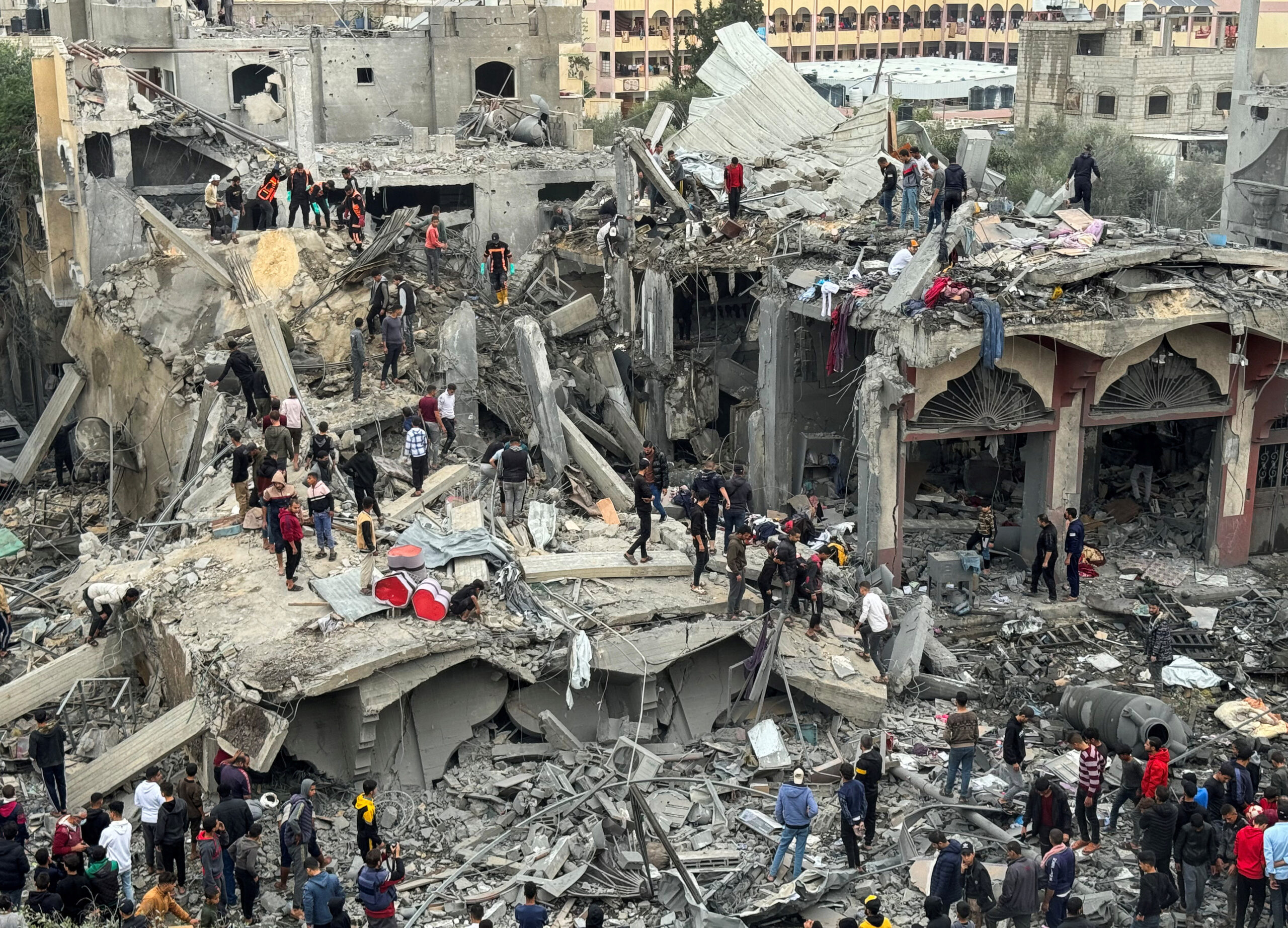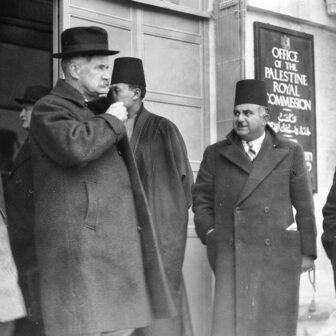Since 7 October, Israel has invaded northern Gaza with some 40,000 combat troops and pummelled the small area with one of the most intense bombing campaigns in history. Nearly two million people have fled their homes as a result. More than 15,000 civilians (including some 6000 children and 5000 women) have been killed in the attacks, according to Gaza’s Hamas-run health ministry, and the US State Department has suggested that the true toll may be even higher. Israel has bombed hospitals and ambulances and wrecked about half of northern Gaza’s buildings. It has cut off virtually all water, food deliveries and electricity generation for Gaza’s 2.2 million inhabitants. By any definition, this campaign counts as a massive act of collective punishment against civilians.
Even now, as Israeli forces push deeper into southern Gaza, the exact purpose of Israel’s approach is far from clear. Although Israeli leaders claim to be targeting Hamas alone, the evident lack of discrimination raises real questions about what the government is actually up to.
Is Israel’s eagerness to shatter Gaza a product of the same incompetence that led to the massive failure of the Israeli military to counter Hamas’s attack on 7 October, the plans for which ended up in the hands of Israeli military and intelligence officials more than a year earlier? Is wrecking northern Gaza and now southern Gaza a prelude to sending the territory’s entire population to Egypt, as proposed in a “concept paper” produced by the Israeli Intelligence Ministry?
Whatever the ultimate goal, Israel’s collective devastation of Gaza raises deep moral problems. But even judged purely in strategic terms, Israel’s approach is doomed to failure — and indeed, it is already failing. Mass civilian punishment has not convinced Gaza’s residents to stop supporting Hamas. To the contrary, it has only heightened resentment among Palestinians. Nor has the campaign succeeded in dismantling the group ostensibly being targeted. Fifty-plus days of war show that while Israel can demolish Gaza, it cannot destroy Hamas. In fact, the group may be stronger now than it was before.
Israel is hardly the first country to err by placing excessive faith in the coercive magic of airpower. History shows that the large-scale bombing of civilian areas almost never achieves its objectives. Israel would have been better off had it heeded these lessons and responded to the 7 October attack with surgical strikes against Hamas’s leaders and fighters in lieu of the indiscriminate bombing campaign it has chosen.
But it is not too late to shift course and adopt a viable alternative strategy for achieving lasting security, an approach that would drive a political wedge between Hamas and the Palestinians rather than bringing them closer together: take meaningful, unilateral steps towards a two-state solution.
Since the dawn of airpower, countries have sought to bomb enemies into submission and shatter civilian morale. Pushed to their breaking point, the theory goes, populations will rise up against their own governments and switch sides. This strategy of coercive punishment reached its apogee in the second world war. History remembers the indiscriminate bombing of cities in that war simply by the place names of the targets: Hamburg (40,000 dead), Darmstadt (12,000) and Dresden (25,000).
Now Gaza can be added to this infamous list. Israeli prime minister Benjamin Netanyahu has himself likened the current campaign to the Allies’ fight in the second world war. While denying that Israel was engaging in collective punishment, he pointed out that a Royal Air Force strike targeting Gestapo headquarters in Copenhagen killed scores of schoolchildren.
What Netanyahu left unmentioned was that none of the Allies’ efforts to punish civilians en masse actually succeeded. In Germany, the Allied bombing campaign, which began in 1942, wreaked havoc on civilians, destroying one urban area after another and ultimately a total of fifty-eight German cities and towns by the end of the war. But it never sapped civilian morale or prompted an uprising against Adolf Hitler, despite the confident predictions of Allied officials. Indeed, the campaign only encouraged Germans to fight harder for fear of a draconian postwar peace.
That failure should not have been so surprising given what happened when the Nazis tried the same tactic. The Blitz, their bombing of London and other British cities in 1940–41, killed more than 40,000 people and yet British prime minister Winston Churchill refused to capitulate. Instead, he invoked the civilian casualties in rallying society to make the sacrifices necessary for victory. Rather than shattering morale, the Blitz motivated the British to organise a years-long effort — with their US and Soviet allies — to counterattack and ultimately conquer the country that had bombed them.
In fact, never in history has a bombing campaign caused the targeted population to revolt against its own government. The United States has tried the tactic numerous times, to no avail. During the Korean war, it destroyed 90 per cent of electricity generation in North Korea. In the Vietnam war, it knocked out nearly as much power in North Vietnam. And in the Gulf war, US air attacks disrupted 90 per cent of electricity generation in Iraq. In none of these cases did the population rise up.
The war in Ukraine is the most recent case in point. For nearly two years Russia has sought to coerce Ukraine through wave after wave of devasting air assaults on cities across the country, killing more than 10,000 civilians, destroying more than 1.5 million homes and displacing some eight million Ukrainians. Russia is clearly shattering Ukraine. But far from crushing Ukraine’s fighting spirit, this massive civilian punishment has only convinced Ukrainians to fight Russia more intensely than ever.
This historical pattern is repeating itself in Gaza. Despite nearly two months of heavy military operations — virtually unrestrained by the United States and the rest of the world — Israel has achieved only marginal results. By any meaningful metric, the campaign has not led to Hamas’s even partial defeat.
Israel’s air and ground operations have killed as many as 5000 Hamas fighters (according to Israeli officials) out of a total of about 30,000. But these losses will not significantly reduce the threat to Israeli civilians, since, as the 7 October attacks proved, it takes only a few hundred Hamas fighters to wreak havoc on Israeli communities. Worse, Israeli officials also admit that the military campaign is killing twice as many civilians as Hamas fighters. In other words, Israel is almost certainly producing more terrorists than it is killing, since each dead civilian will have family and friends eager to join Hamas to exact revenge.
Hamas’s military infrastructure, such as it is, has not been meaningfully dismantled, even after the much-vaunted operations against the al-Shifa hospital, which the Israeli military alleged Hamas used as an operational base. As videos released by the Israel Defense Forces show, Israel has captured and destroyed the entrances to many of Hamas’s tunnels, but these can eventually be repaired, just as they were built in the first place.
More important, Hamas’s leaders and fighters appear to have abandoned the tunnels before Israeli forces entered them, meaning that the group’s most important infrastructure — its fighters — survived. Hamas has an advantage over Israeli forces: it can easily abandon a fight, blend into the civilian population, and live to fight again on more favourable terms. That is why a large-scale Israeli ground operation is also doomed to failure.
More broadly, Israel’s military campaign has not deeply weakened Hamas’s control over Gaza. Israel has rescued only one of the 240 or so hostages taken in the 7 October attack; the other hostages freed have been released by Hamas, showing that the group remains in control of its fighters.
Despite large-scale power shortages and extensive destruction throughout Gaza, Hamas continues to churn out propaganda videos showing civilian atrocities committed by Israeli forces and intense battles between Hamas fighters and Israeli troops. The group’s propaganda is distributed widely on the messaging app Telegram, where its channel has more than 620,000 subscribers. By the count of the University of Chicago Project on Security and Threats (which I direct), Hamas’s military wing, the Qassam Brigades, has disseminated nearly 200 videos and posters every week from 11 October to 22 November through that channel.
The only way to deal a lasting defeat to Hamas is to attack its leaders and fighters while separating them from the surrounding population. That is easier said than done, however, especially since Hamas draws its ranks directly from the local population rather than from abroad.
Indeed, survey evidence shows the extent to which Israel’s military operations are now producing more terrorists than they are killing. In a 14 November poll of Palestinians in Gaza and the West Bank conducted by Arab World for Research and Development, 76 per cent of respondents said they viewed Hamas positively. Compare that with the 27 per cent of respondents in both territories who told different pollsters in September that Hamas was “the most deserving of representing the Palestinian people.” The implication is sobering: a vast portion of the more than 500,000 Palestinian men between the ages of eighteen and thirty-four are now ripe recruits for Hamas or other Palestinian groups seeking to target Israel and its civilians.
This result also reinforces the lessons of history. Contrary to conventional wisdom, most terrorists do not choose their vocation owing to religion or ideology, although some certainly do. Rather, most people who become terrorists do so because their land is being taken away.
For decades, I’ve studied the most extreme terrorists — suicide terrorists — and my study of 462 people who killed themselves on missions to kill others in acts of terrorism from 1982 to 2003 remains the largest demographic study of these attackers. I found that there are hundreds of secular suicide terrorists. Indeed, the world’s leader in suicide terrorism during that period was the Tamil Tigers, an openly anti-religious, Marxist group in Sri Lanka that carried out more suicide attacks than Hamas or Palestine Islamic Jihad — the two deadliest Palestinian terrorist groups — combined. What 95 per cent of the suicide terrorists in my database had in common was that they were fighting back against a military occupation that was controlling territory they considered their homeland.
From 1994 to 2005, Hamas and other Palestinian terrorist groups carried out more than 150 suicide attacks, killing about 1000 Israelis. Only when Israel withdrew military forces from Gaza did these groups abandon the tactic almost entirely. Since then, the number of Palestinians in Gaza and the West Bank has grown by 50 per cent, making it even harder for Israel to control the territories in the long run. There is every reason to think that Israel’s renewed military occupation of Gaza — “for an indefinite period,” according to Netanyahu — will lead to a new, perhaps larger wave of suicide attacks against Israeli civilians.
Although the Israeli–Palestinian conflict has many dimensions, one fact helps clarify the complex picture. Virtually every year since the early 1980s, the Jewish population in the Palestinian territories has grown, even during the years of the Oslo peace process in the 1990s. The growth of settlements has meant the loss of land for the Palestinians and increasing concerns that Israel will confiscate more land to resettle more Jews in the Palestinian territories. Indeed, Yossi Dagan, a prominent settler and member of Netanyahu’s party, has urged the creation of settlements in Gaza, where the last settlements were removed in 2005.
The growth of the Jewish population in Palestinian territories is a central factor in fomenting conflict. In the years immediately after the 1967 Arab–Israeli war, the total number of Jews living in the West Bank and Gaza numbered only a few thousand. Israeli–Palestinian relations were mostly harmonious. No Palestinian suicide attacks and few attacks of any kind occurred during this period.
But things changed after the right-wing government led by the Likud Party came to power in 1977, promising a major expansion of settlements. The number of settlers increased — from about 4000 in 1977 to 24,000 in 1983 and to 116,000 in 1993. By 2022, about 500,000 Jewish Israeli settlers lived in the Palestinian territories, excluding East Jerusalem, where an additional 230,000 Jews resided. As the settlements grew, the relative harmony between the Israelis and the Palestinians dissipated. First came the creation of Hamas in 1987, and then the first intifada of 1987–93, the second intifada of 2000–2005, and continuing rounds of conflict between Palestinians and Israelis ever since.
The near-continuous growth of the Jewish settlements is a core reason why the idea of a two-state solution has lost credibility since the 1990s. If there is to be a serious pathway to a Palestinian state in the future, that growth must come to an end. After all, why should Palestinians reject Hamas and support a supposed peace process if doing so means only more loss of their land?
Only a two-state solution will lead to lasting security for Israelis and Palestinians alike. That is the only viable approach that will truly undermine Hamas, and Israel can and should unilaterally press forward with a plan, taking steps on its own before negotiating with the Palestinians. The goal should be to revive a process that has been dormant since the last negotiations failed in 2008, fifteen years ago.
To be clear, Israel should couple this political approach with a military one, engaging in limited, sustained operations against the Hamas leaders and fighters responsible for the atrocities of 7 October. But the country must adopt the political element of the strategy now, not later. Israel cannot wait until after some mythical time when Hamas is defeated by military might alone.
Those who doubt that a two-state solution can ever be reached are right that immediately resuming negotiations with the Palestinians would not reduce Hamas’s will to fight. For one thing, the group is an avowed proponent of eliminating Israel. For another, it would be one of the biggest losers in a two-state solution, since a peace deal would almost certainly involve the prohibition of armed Palestinian groups aside from Hamas’s main internal rival, the Palestinian Authority, which would likely enjoy renewed support and legitimacy if it secured an agreement that the majority of Palestinians supported. And even if a two-state solution is achieved, Israel will still need a strong defence capability, since no political solution can completely eliminate the threat of terrorism for years to come.
But that is why the goal now should not be to immediately put forward a final plan for a two-state solution — something that is simply not in the realm of political possibility at the moment. Instead, the immediate objective should be to create a pathway for an eventual Palestinian state. Although sceptics claim that such a pathway is impossible because Israel has no suitable Palestinian partners, Israel can in fact take crucial steps on its own.
The Israeli government could publicly announce that it intends to achieve a state of affairs where the Palestinians live in a state chosen by Palestinians side by side with a Jewish state of Israel. It could announce that it intends to develop a process to achieve that goal by, say, 2030, and will lay out milestones for getting there in the coming months. It could announce that it will immediately freeze Jewish settlements in the West Bank and forgo such settlements in Gaza through to 2030 as a down payment that demonstrated its commitment to a genuine two-state solution. And it could announce that it is willing and ready to work with all parties — all countries in the region and beyond, all international organisations, and all Palestinian parties — that are willing to accept these objectives.
Far from being irrelevant to Israel’s military efforts against Hamas, these political steps would augment a sustained, highly targeted campaign to reduce the near-term threat of attacks from the group. Effective counterterrorism benefits from intelligence from the local population, which is far more likely to be forthcoming if that population has hope of a genuine political alternative to the terrorist group.
Indeed, in the long run, the only way to defeat Hamas is to drive a political wedge between it and the Palestinian people. Unilateral Israeli steps signalling a serious commitment to a new future would decidedly change the framework of and dynamics in the Israeli–Palestinian relationship and give Palestinians a genuine alternative to simply supporting Hamas and violence. Israelis, for their part, would be more secure, and the two parties would at long last be on a path towards peace.
Of course, the current Israeli government shows no signs of pursuing this plan. That could change, however, especially if the United States decided to use its influence. For instance, the White House could apply more private pressure to Netanyahu’s government to curtail indiscriminate attacks in the air campaign.
But perhaps the most important step that Washington could take now would be to jump-start a major public debate about Israel’s conduct in Gaza, one that allowed alternative strategies to be considered in depth and that brought forth rich public information for Americans, Israelis and people around the world to evaluate the consequences for themselves. The White House could release US government assessments of the effect that Israel’s military campaign in Gaza is having on Hamas and Palestinian civilians. Congress could hold hearings centred on a simple question: is the campaign producing more terrorists than it is killing?
The failure of Israel’s current approach is becoming clearer by the day. Sustained public discussion of that reality, combined with serious consideration of smart alternatives, offers the best chance for convincing Israel to do what is, after all, in its own national interest. •




